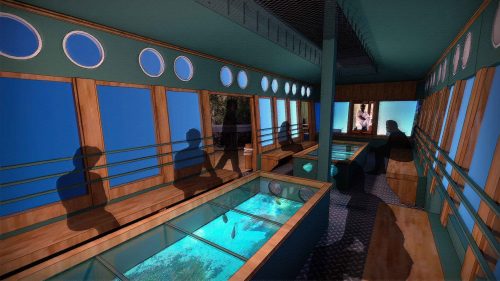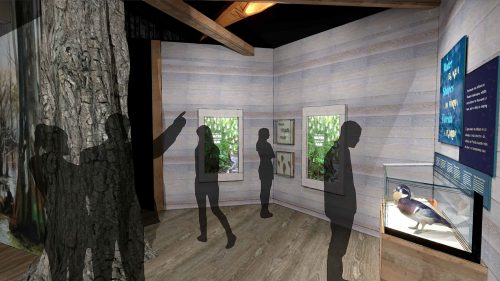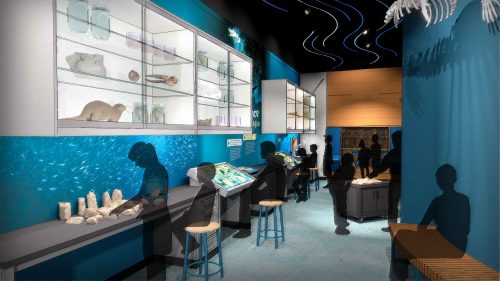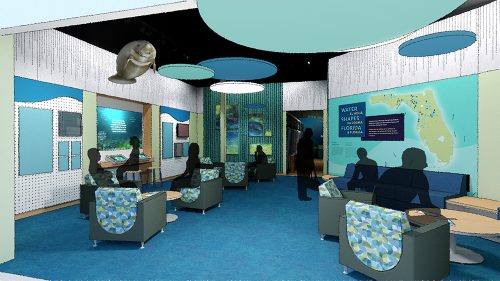GAINESVILLE, Fla. — Go with the flow in the Florida Museum of Natural History’s new permanent exhibit, “Water Shapes Florida,” opening March 23.
This engaging bilingual exhibit, available in English and Spanish, uses an immersive theater, reconstructed habitats, interactive activities and museum objects to tell the story of Florida’s fresh water.

“Florida is famous for its beaches and coastal waters, but I think people will be amazed to discover just how much fresh water we have in the state, both above and below ground,” said Julie Waters, exhibit coordinator at the Florida Museum. “We hope visitors leave with a new appreciation of our fresh water resources and are inspired to become caretakers of its future.”
Florida’s freshwater springs play a leading role in the new exhibit. A glass-bottom-boat theater simulates a short journey around some local springs, complete with looks at the plants and animals underwater and an overhead view of the landscape. Captain Bill guides and educates guests through the waters as this immersive experience rides, dives and flies through some of the Sunshine State’s most famous waterways.

Real objects and specimens from the collections showcase cultural items linked to water and the biodiversity of freshwater biomes, past and present. The Springs Gallery uncovers more about these unique water sources and how people have been connected to them for thousands of years, dating back to Florida’s first inhabitants.
After more than 20 years, the museum’s “Northwest Florida: Waterways and Wildlife” exhibit was closed Feb. 27, 2023 to be updated as part of its transformation to “Water Shapes Florida.” In addition to the museum’s exhibits team, this collaborative project also included a variety of professionals — from architects and engineers to scientists and educators — to create an enriching new experience.
After a year of renovation, the museum’s iconic cave and surrounding habitat return after being carefully cleaned and updated, offering a refreshed look at this visitor favorite. Video screens have been added to illustrate the aquifer below while a lush hammock forest reveals the plants and animals that call it home.

“Although it was bittersweet to remove components that I helped create, I am really excited about the ways ‘Water Shapes Florida’ builds on the best of the former exhibit while bringing new life and engagement,” said Dale Johnson, operations manager at the Florida Museum. “The flood-plain forest and cave are getting updated content, new interactive components and lighting to illuminate the magic of these spaces.”
Conservation and the environment are also important themes throughout the exhibit. The Water Lab reveals more about the significance of the Floridan Aquifer and how pollution enters the water cycle. Guests can also learn about current issues affecting Florida’s water and how to protect it.

“Water is arguably Florida’s most important resource and defines our state in many ways. But our water resources also have plenty of challenges,” said Darcie MacMahon, the Florida Museum’s director of exhibits and public programs. “As the state museum of natural history, we wanted to center and celebrate the story of water — how it supports all life, provides incredible opportunities for enjoyment and ultimately depends on us to be good stewards.”
“Water Shapes Florida” was made possible by the generous support of museum donors and is sponsored in part by the 1923 Fund, Florida Division of Historical Resources, B.J. and Eve Wilder Family Foundation Inc., Duke Energy Foundation, Felburn Foundation, Anne and John Shermyen, Fish & Wildlife Foundation of Florida, Giovanna Holbrook, Jack Martin, PepsiCo Foundation, Frances C. and William P. Smallwood Foundation and Rotary Club of Downtown Gainesville.
For more information, visit www.floridamuseum.ufl.edu/exhibits/water-shapes-florida or call 352-846-2000.
-30-
Writer: Nikhil Srinivasan, nsrinivasan@floridamuseum.ufl.edu
Source: Julie Waters, jmwaters@flmnh.ufl.edu; Dale Johnson, dalej@flmnh.ufl.edu; Darcie MacMahon, dmacmahon@flmnh.ufl.edu
Media Contact: Kaitlin Gardiner, kgardiner@floridamuseum.ufl.edu